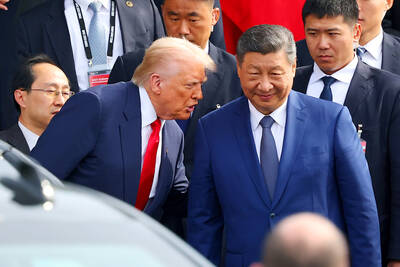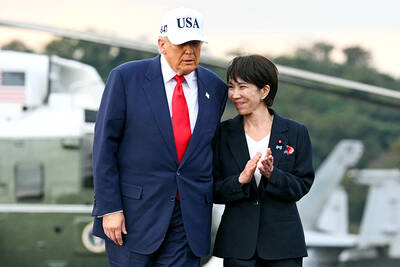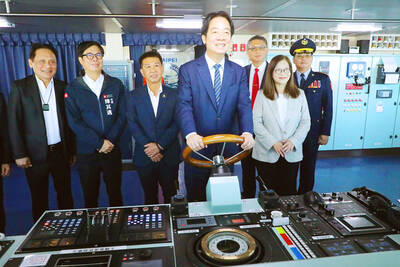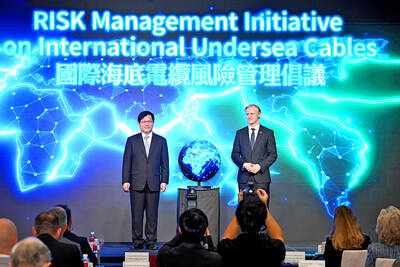Left out of the US-backed Trans-Pacific Partnership (TPP) trade pact struck last week, China and India approach this week’s talks for a huge Asia-wide equivalent with fresh urgency, lest competitor nations steal a march on export access.
Beijing is a key driver of the Regional Comprehensive Economic Partnership (RCEP), a proposed 16-nation free-trade area that would be the world’s biggest such bloc, encompassing 3.4 billion people.
“Member countries will be under pressure to fast-track negotiations for RCEP,” said a senior official in India, which is keen to avoid being excluded from major trade accords.
While China’s rivalries with India and Japan are likely to complicate progress, it has incentive to get things moving.
China’s central bank estimates the world’s second-largest economy could forfeit a 2.2 percent boost to GDP if Beijing does not join the TPP, according to a commentary by People’s Bank of China chief economist Ma Jun (馬駿) published in the official Shanghai Securities News on Friday.
China stands to lose ground to manufacturing competitors such as Vietnam, which as a TPP member is to have greater duty-free access to the US and other member nations, Beijing-based University of International Business and Economics professor Tu Xinquan (屠新泉).
“It’s not that there is a competition between the RCEP and the TPP, but overall, because of the pressure put on by the TPP, there’s hope for a faster end to negotiations for more liberalized trade in the region,” Tu said.
The RCEP was first conceived by ASEAN, but China is increasingly prominent as backer of the proposed pact.
While the RCEP has largely been seen as an alternative to US-led trade plans, some say that view is evolving.
China might ultimately look to steer RCEP talks toward a broader pact that would encompass the TPP into a Free Trade Area of the Asia-Pacific, Seoul-based Korea Institute for International Economic Policy head of regional trade studies Kim Young-gui said — an idea first put forward by APEC.
Seven countries — Australia, Japan, Malaysia, New Zealand, Singapore, Vietnam and Brunei — are in both the TPP and RCEP.
“New Zealand views TPP and RCEP as complementary stepping stones to the vision of a Free Trade Area of the Asia Pacific,” a New Zealand Ministry of Foreign Affairs and Trade spokesperson said.
The TPP, reached on Monday last week after marathon talks between the US and 11 other Pacific Rim nations, aims to liberalize commerce in 40 percent of the world’s economy and would be a legacy-defining victory for US President Barack Obama.
Obama wants the TPP to help boost US influence in East Asia and counter the rise of China, but Beijing officially welcomed the pact, saying it hoped the deal would promote Asia-Pacific trade.
“We hope that regardless of whether it is the TPP or the RCEP, they both can supplement, promote and be beneficial to strengthening the multilateral trade system,” Chinese Ministry of Foreign Affairs spokeswoman Hua Chunying (華春瑩) said.

UKRAINE, NVIDIA: The US leader said the subject of Russia’s war had come up ‘very strongly,’ while Jenson Huang was hoping that the conversation was good Chinese President Xi Jinping (習近平) and US President Donald Trump had differing takes following their meeting in Busan, South Korea, yesterday. Xi said that the two sides should complete follow-up work as soon as possible to deliver tangible results that would provide “peace of mind” to China, the US and the rest of the world, while Trump hailed the “great success” of the talks. The two discussed trade, including a deal to reduce tariffs slapped on China for its role in the fentanyl trade, as well as cooperation in ending the war in Ukraine, among other issues, but they did not mention

Japanese Prime Minister Sanae Takaichi yesterday lavished US President Donald Trump with praise and vows of a “golden age” of ties on his visit to Tokyo, before inking a deal with Washington aimed at securing critical minerals. Takaichi — Japan’s first female prime minister — pulled out all the stops for Trump in her opening test on the international stage and even announced that she would nominate him for a Nobel Peace Prize, the White House said. Trump has become increasingly focused on the Nobel since his return to power in January and claims to have ended several conflicts around the world,

CALL FOR SUPPORT: President William Lai called on lawmakers across party lines to ensure the livelihood of Taiwanese and that national security is protected President William Lai (賴清德) yesterday called for bipartisan support for Taiwan’s investment in self-defense capabilities at the christening and launch of two coast guard vessels at CSBC Corp, Taiwan’s (台灣國際造船) shipyard in Kaohsiung. The Taipei (台北) is the fourth and final ship of the Chiayi-class offshore patrol vessels, and the Siraya (西拉雅) is the Coast Guard Administration’s (CGA) first-ever ocean patrol vessel, the government said. The Taipei is the fourth and final ship of the Chiayi-class offshore patrol vessels with a displacement of about 4,000 tonnes, Lai said. This ship class was ordered as a result of former president Tsai Ing-wen’s (蔡英文) 2018

GLOBAL PROJECT: Underseas cables ‘are the nervous system of democratic connectivity,’ which is under stress, Member of the European Parliament Rihards Kols said The government yesterday launched an initiative to promote global cooperation on improved security of undersea cables, following reported disruptions of such cables near Taiwan and around the world. The Management Initiative on International Undersea Cables aims to “bring together stakeholders, align standards, promote best practices and turn shared concerns into beneficial cooperation,” Minister of Foreign Affairs Lin Chia-lung (林佳龍) said at a seminar in Taipei. The project would be known as “RISK,” an acronym for risk mitigation, information sharing, systemic reform and knowledge building, he said at the seminar, titled “Taiwan-Europe Subsea Cable Security Cooperation Forum.” Taiwan sits at a vital junction on